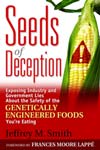
Controlling The World's
Food!
Seeds of
Deception — Genetically Engineered Foods!
|
Book Introduction On May 23, 2003, President Bush proposed an Initiative to End Hunger in Africa using genetically modified (GM) foods. He also blamed Europe's "unfounded, unscientific fears" of these foods for thwarting recovery efforts. Bush was convinced that GM foods held the key to greater yields, expanded U.S. exports, and a better world. His rhetoric was not new. It had been passed down from president to president, and delivered to the American people through regular news reports and industry advertisements. The message was part of a master plan that had been crafted by corporations determined to control the world's food supply. This was made clear at a biotech industry conference in January 1999, where a representative from Arthur Anderson Consulting Group explained how his company had helped Monsanto create that plan. First, they asked Monsanto what their ideal future looked like in fifteen to twenty years. Monsanto executives described a world with 100 percent of all commercial seeds genetically modified and patented. Anderson Consulting then worked backwards from that goal, and developed the strategy and tactics to achieve it. They presented Monsanto with the steps and procedures needed to obtain a place of industry dominance in a world in which natural seeds were virtually extinct. Integral to the plan was Monsanto's influence in government, whose role was to promote the technology worldwide and to help get the foods into the marketplace quickly, before resistance could get in the way. A biotech consultant later said, "The hope of the industry is that over time, the market is so flooded that there's nothing you can do about it. You just sort of surrender." The anticipated pace of conquest was revealed by a conference speaker from another biotech company. He showed graphs projecting the year-by-year decrease of natural seeds, estimating that in five years, about 95 percent of all seeds would be genetically modified. While some audience members were appalled at what they judged to be an arrogant and dangerous disrespect for nature, to the industry this was good business. Their attitude was illustrated in an excerpt from one of Monsanto's advertisements: "So you see, there really isn't much difference between foods made by Mother Nature and those made by man. What's artificial is the line drawn between them." To implement their strategy, the biotech companies needed to control the seeds-so they went on a buying spree, taking possession of about 23 percent of the world's seed companies. Monsanto did achieve the dominant position, capturing 91 percent of the GM food market. But the industry has not met their projections of converting the natural seed supply. Citizens around the world, who do not share the industry's conviction that these foods are safe or better, have not "just sort of surrendered." Widespread resistance to GM foods has resulted in a global showdown. U.S. exports of genetically modified corn and soy are down, and hungry African nations won't even accept the crops as food aid. Monsanto is faltering financially and is desperate to open new markets. The U.S. government is convinced that EU resistance is the primary obstacle and is determined to change that. On May 13, 2003, the U.S. filed a lawsuit with the World Trade Organization (WTO), charging that the European Union's restrictive policy on GM food violates international agreements. On the day the WTO suit was filed, U.S. Trade Representative Robert Zoellick declared, "Overwhelming scientific research shows that biotech foods are safe and healthy." This has been industry's chant from the start. It is the key assumption at the basis of their master plan, the WTO challenge, and the president's campaign to end hunger. It is also, however, untrue. The following chapters reveal that it was industry influence, not sound science, which allowed these foods onto the market. Moreover, if overwhelming scientific research suggests anything, it is that the foods should never have been approved. Just as the magnitude of the industry's plan was breathtaking, so to are the distortions and cover-ups. While many of the stories in this book reveal government and corporate maneuvering worthy of an adventure novel, the impact of GM foods is personal. Most people in North America eat them at every meal. These chapters not only dismantle the U.S. position that the foods are safe, they inform you of the steps you can take to protect yourself and your family. |
“And God said, Let the earth bring forth the living creature after his kind, cattle, and creeping thing, and beast of the earth after his kind: and it was so.” —Genesis 1:24